|
Getting your Trinity Audio player ready...
|
Established in 1938
Located in Washington state, Olympic National Park is home to the Lower 48’s only rain forests. Scenic views range from craggy beaches to glacier-covered mountains, crystal lakes and pastoral woodland trails. This wild area has otherworldly beauty.
Overview
Olympic National Park is a patchwork of different ecosystems: its glacial peaks, old growth forests, and Olympic Mountains were formed 34 million years ago. The varied ecosystems include subalpine, coast, temperate forests and lowland forests. With such variability, Olympic National Park seems like many parks in one. The mountain ranges are like a crown, famous for its climbing and hiking trails which cut through the thick rainforests.
This World Heritage Site is isolated from other mountain ranges and surrounded by the waters of the Pacific Ocean and Puget Sound. Adventurers can see wildlife including bald eagles, marmots, elk, mountain goats, black bears, and even whales. Hurricane Ridge, rising over a mile above sea level, houses a visitor center and hiking trails featuring panoramic views of the rugged, snow-caped peaks of nearby Mount Olympus, the Blue Glacier and the pastoral green forest lands.
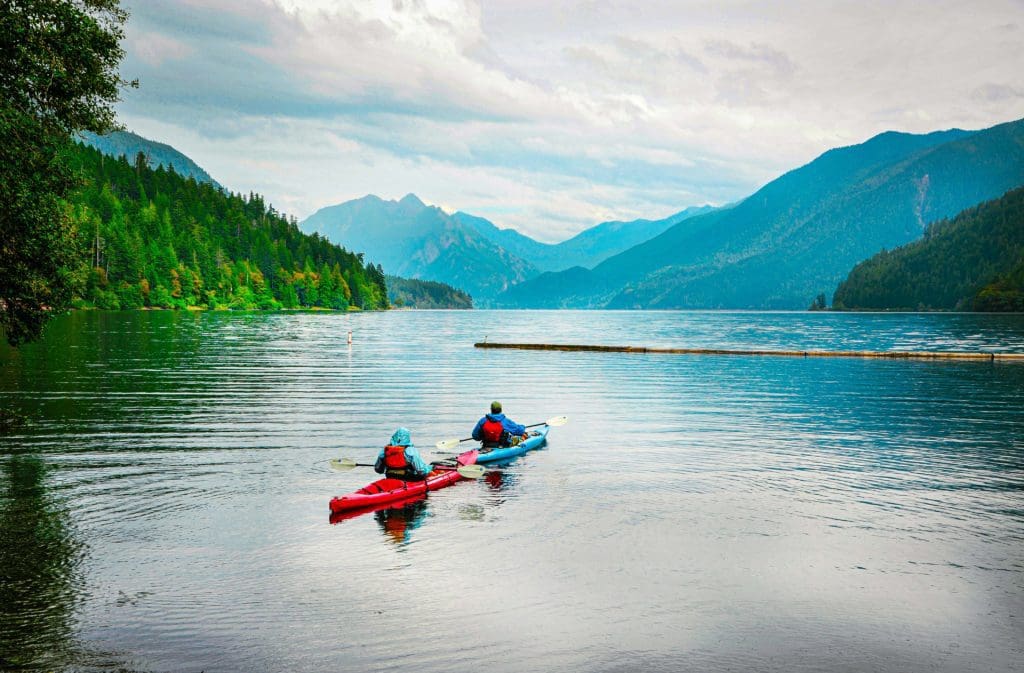
Kayaking on Lake Crescent in Olympic Park, Washington.
Olympic National Park has lots to see, so it takes several days to see everything. An array of water-based activities can be found at the park, including fishing, kayaking and boating. Ocean lovers can enjoy the crashing waves or peaceful walks along the beach at low tide. In winter, snow sports include snowshoeing, tubing, cross-country skiing and downhill skiing in the high country.
Visitors to the park have several options for lodging. Overnight backpackers, campers, RVers, and people staying in cottages or lodges will find comfortable accommodations.
Table of Contents:
Article Navigation: Click on any of the listed items in the table of contents below to jump to that section of the article. Similarly, clicking on any large, white section header will jump you back to the Table of Contents.
Getting There
Olympic National Park is approximately 90 miles (145 kilometers) west of Seattle. Most park destinations can be reached via U.S. Highway 101, which circumnavigates the Olympic Peninsula. Clallam Transit serves several locations around the Olympic Peninsula and Olympic National Park, including Port Angeles, Forks, La Push, Lake Crescent, and Neah Bay.
Traveling to Olympic National Park from Seattle by car is the best way to get there, because U.S. Highway 101 runs through the park’s most well-developed areas, including Port Angeles and Port Townsend. Washington State has ferry service from the Seattle area that provides transportation directly to its northeastern regions, including Port Angeles and Port Townsend.
Human History
Before the influx of European settlers, Olympic’s human population consisted of Native Americans. Recent reviews of the record and systematic archaeological surveys are pointing to much more extensive tribal use of the mountains than seemed to be the case.
There is archaeological evidence that the people who inhabit the area now call Olympic National Park had been there 12,000 years ago. For example, Native American hunters took down the mastodons in the area around present-day Sequim. Whaling villages along the coast of Ozette were another example. And some Native American families traveled through the Olympic Mountains and into neighboring villages to visit each other. All of these groups had inhabited and used the land before European Americans arrived to settle and develop it.
Olympic National Park is adjacent to the reservations of several Native American tribes, including the Skokomish, Mahah, Hoh, Quinault, Quileute, Jamestown S’Klallam, Port Gamble S’Klallam, and Lower Elwaha Klallam. Each of these tribes have strong cultural ties to the land. Traditions of the coastal tribes include the potlatch, an elaborate feast and social gathering.
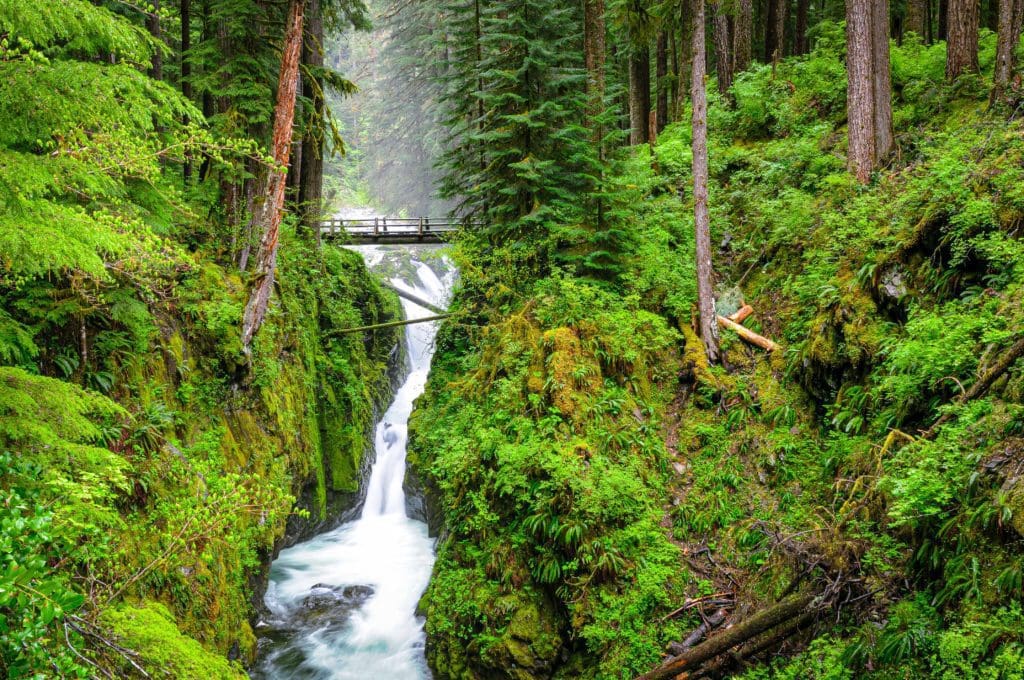
Sol Duc Falls at Olympic National Park, Washington.
The Spanish explored this area in the 1770s. They established a beachhead at Neah Bay in 1792, but it was abandoned months later. Many pioneers arrived in the 1800s. The first permanent settlement was founded in Port Townsend in 1851.
From the late nineteenth century to the early twentieth century, logging took off in the Pacific Northwest. Public dissent began to take hold in the 1920s when people got their first glimpses of clear-cut hillsides. The use of cars and tourism further fueled people’s interest in nature and their surroundings.
When logging began in the Pacific Northwest, the increasing demand for timber began in the late 19th century. As people became more interested in leisure activities, they started to take road trips and go to places like the Olympic Peninsula; however, when they took their first drive through the region and saw clear-cut hillsides, they began to fear that this type of logging could be harming the natural environment. These concerns began to emerge in public forums in the 1920s.
Public support for preserving some of the area began to grow, and President Franklin D. Roosevelt signed a bill that created a national park in 1938. The Civilian Conservation Corps created a headquarters in 1939 with funding from the Public Works Administration. It is now listed on the National Register of Historic Places. The park’s territory was expanded in 1953 by 47,753 acres (19,325 ha), including parts of the Queets and Hoh valleys, along with the Pacific coast between the Queets and Hoh rivers.
Even though Olympic National Park was created to protect the land, illegal logging continued after it was established. Today, political battles are still being fought over some of the land in the park, which continues to be logged.
Ecology
Olympic National Park boasts an incredibly diverse ecosystem, encompassing three distinct environments: the Pacific coastline, the western-side temperate rainforest, and the drier eastern side. This unique park, established in 1938, protects nearly a million acres, including thousands of years of human history. It’s a haven for biodiversity and offers a wealth of educational and learning opportunities.
One of the most distinctive features of Olympic National Park is its old-growth temperate rainforest, one of the largest remaining blocks in the lower 48 states. These forests are home to a wide variety of flora and fauna, including 70 mammal species, over 1,000 plant species, and numerous bird and fish species.
The coastal rainforest is particularly notable for its lush vegetation, with moss-covered trees and vibrant ferns creating a verdant landscape. This environment is essential for the survival of many species, providing a rich habitat for a diverse array of wildlife.
The nearby city of Seattle is well known for its heavy rainfall. Olympic weather is also famously wet, so it’s not surprising that the USA’s only rain forest is in the Pacific Northwest. Olympic National Park is home to temperate rainforests, where mosses, ferns, red alders, Sitka spruce and Douglas fir grow. These rainforests are also home to epiphytes like cat-tail moss and licorice ferns. The wet and warm conditions result in dense and lush woodlands with numerous wonderful hikes where tall trees and wildlife are abundant.
Huge Pacific Northwest temperate rainforests once stretched from Oregon’s southern coast to southeastern Alaska. Because of development, very few exist outside of Olympic National Park today. Olympic is home to four rain forests where you can explore the Hoh, Quinault, Queets and Bogchiel rain forests.
The park’s varied terrain also includes glacier-capped mountains, offering spectacular views and challenging hikes for visitors. These mountains, formed by tectonic activity, volcanic eruptions, glaciation, and erosion, have a complex geologic history that spans millions of years.
In addition to its terrestrial ecosystems, Olympic National Park protects 73 miles of wild coastline, featuring tidepools filled with colorful sea stars, hermit crabs, and anemones; looming sea stacks and rock arches; and steep headland cliffs. The park’s marine ecosystem is home to whales, seals, sea lions, sea otters, raccoons, and eagles, making it an important refuge for wildlife.
The unique combination of ecosystems within Olympic National Park makes it a vital area for conservation and research, with scientists continually studying the park’s diverse flora and fauna to better understand and protect these valuable natural resources.
Olympic National Park is not only a place of beauty and recreation, but it also serves as an important sanctuary for one of the largest remaining blocks of old-growth temperate rainforest. The diverse range of ecosystems found within the park make it an essential location for conservation and research purposes. Scientists are constantly studying the park’s various plant and animal life in order to gain a deeper understanding of these valuable natural resources and ensure their protection.
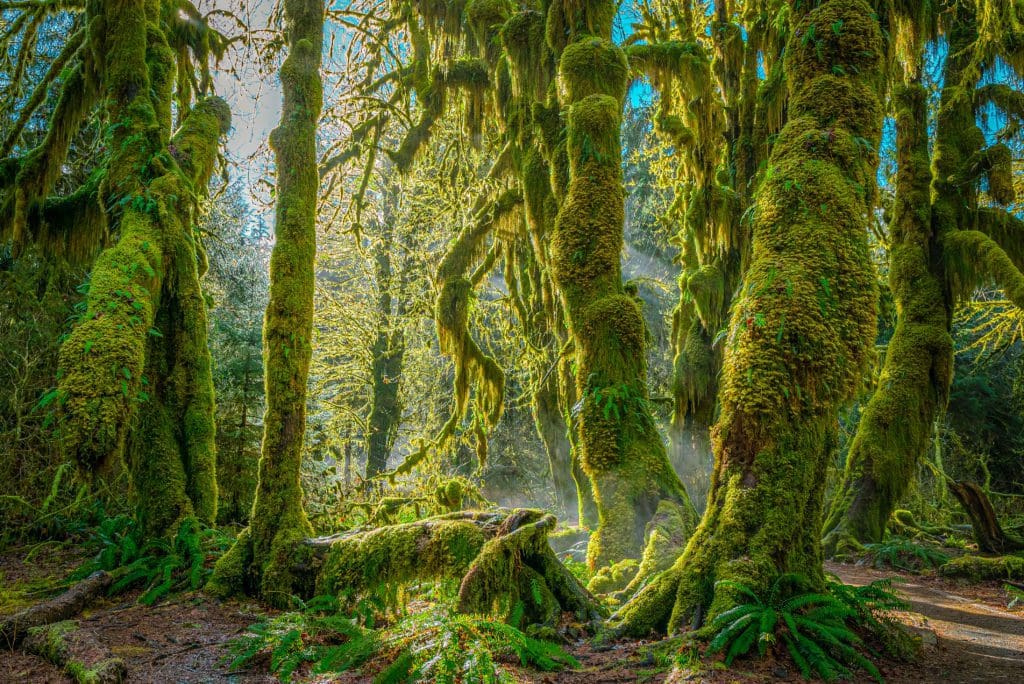
Fairy rain forest is filled with old temperate trees covered in green and brown mosses in the Hoh Rain Forest, Olympic National Park, Washington.
Geology
The history of Olympic National Park’s geology is an intriguing story of tectonic movement, volcanic eruptions, glacial activity, and gradual erosion spanning millions upon millions of years. The Olympic Mountains, situated in the northwest corner of Washington State, have a marine origin. The basaltic and sedimentary rocks that make up these towering peaks were deposited offshore around 18 to 57 million years ago before being uplifted, folded, and worn away over time into the rugged landscape we see today. This geological transformation was made possible by the Juan de Fuca Plate subducting beneath the North American Plate, gradually lifting the Olympic
The majority of the park is composed of igneous and sedimentary rocks, which have been created within the past 60 million years during the Paleocene era. These formations, responsible for the magnificent mountain peaks in Olympic, were initially deposited underwater as an accretionary prism. Due to ongoing subduction, where the denser Juan de Fuca Plate slides under the North American Plate, layers of sediment on top of the Juan de Fuca Plate are scraped off and pushed against the western edge of North America.
The diverse processes at work in Olympic National Park have shaped its distinctive geologic features. These include the rugged sea stacks found along the picturesque coastline, made up of the Hoh rock assemblage. You can also see coastal cliffs, lakes carved by glaciers like Lake Crescent, and evidence of glacial activity such as U-shaped valleys, boulders carried by ice known as erratics, and scree fields.
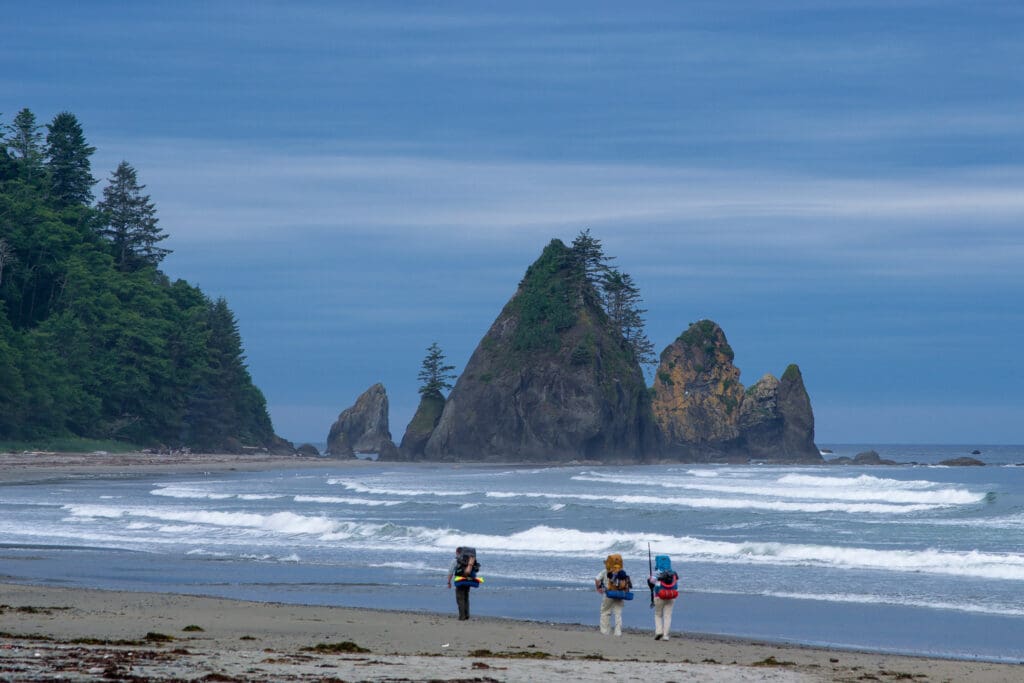
Shi Shi Beach and Point of the Arches, Olympic National Park, Washington.
Where to Stay
For a delightful stay within Olympic National Park, consider the following options:
Lake Crescent Lodge: With a history dating back to 1915, this lodge offers a rustic appeal that beautifully complements its wild surroundings. It’s a great base for exploring the park and is located near the stunning Lake Crescent.
Kalaloch Lodge: Situated on the rugged western coast of the Olympic Peninsula, it’s the only lodging in Olympic National Park next to the ocean. The lodge has a rustic feel with modern touches and is within a short drive from the Hoh Rainforest.
Lake Quinault Lodge: This historic lodge, built in 1926 and listed on the National Register of Historic Places, offers a rustic yet modern experience. It’s an excellent choice for families or anyone looking for a tranquil retreat.
Log Cabin Resort: Located on the shores of Lake Crescent, this resort provides a family-oriented environment with summer fun activities like paddle boats and kayaks. It’s a perfect spot for those seeking a blend of adventure and relaxation.
Sol Duc Hot Springs Resort: Known for its hot mineral spring pools, this resort offers a unique experience within the park. It’s an excellent option for those looking to relax and rejuvenate amidst nature.
Each of these locations offers a unique experience within the diverse ecosystems of Olympic National Park, from the coastal beaches to the temperate rainforests. Make sure to book in advance, especially during the summer months, to secure your preferred accommodation.
Enjoying The Park
Olympic National Park is a stunning and diverse national park with an area of just under 1 million acres. Here are some of the best things to do when visiting this remarkable park:
- Explore the Pacific Coastline: Walk along rugged beaches, marvel at driftwood-strewn shores, and witness impressive sea stacks. Ruby Beach and Rialto Beach are popular spots.
- Visit the Hoh Rainforest: Immerse yourself in the lush greenery of the temperate rainforest. The Hoh Rainforest offers enchanting trails surrounded by moss-covered trees and vibrant ferns1.
- Climb to New Heights: Head to the alpine region in the center of the peninsula. Climb peaks as high as 8,000 feet for breathtaking views of the surrounding landscapes.
- Relax by the Lakes: Enjoy the tranquility of Olympic’s pristine lakes. Lake Crescent and Lake Quinault are perfect for kayaking, swimming, or simply taking in the scenery.
- Soak in Hot Springs: While not directly in the park, Sol Duc Hot Springs (located nearby) offers natural hot pools for a relaxing soak2.
- Chase Waterfalls: Explore the park’s waterfalls, including Marymere Falls and Sol Duc Falls. These short hikes lead to beautiful cascades.
- Experience Winter Wonderland: In winter, explore the park on skis or snowshoes. The snow-covered landscapes create a magical setting.
- Camp Under the Stars: Set up camp in one of the park’s designated campgrounds and enjoy stargazing in this International Dark Sky Park.
Olympic Coast National Marine Sanctuary
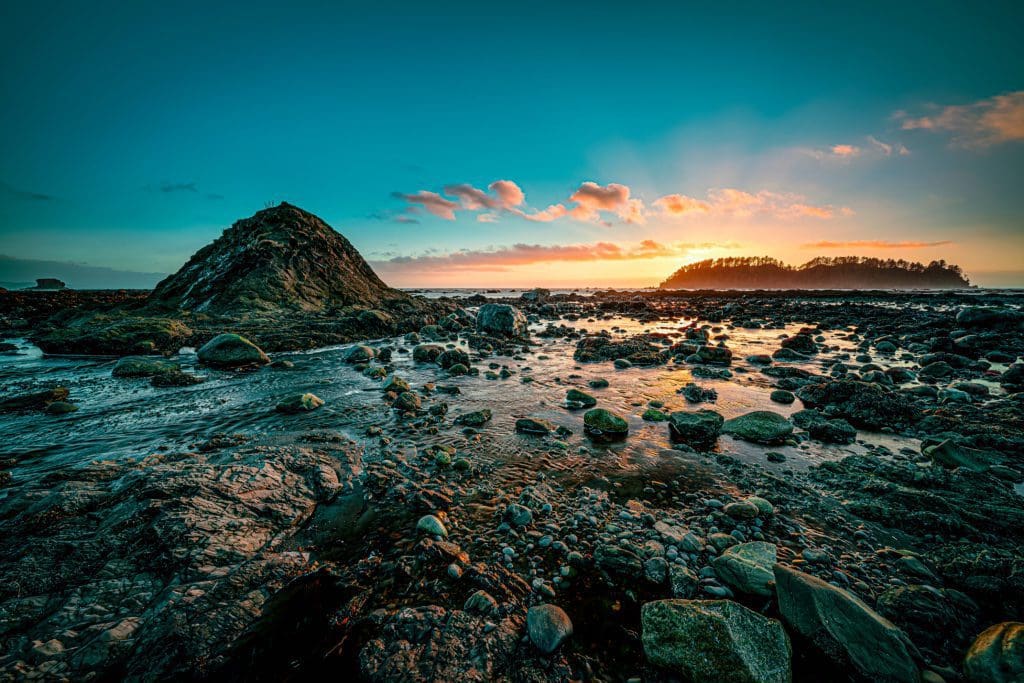
Sunset falls over Cape Alava’s intertidal areas, where the Pacific Ocean tides shape life, Olympic Coast National Marine Sanctuary, Washington.
Olympic National Park’s beaches are a marine wonderland, especially after the waves leave behind nutrient-rich pools after high tide. The park has 70 miles (113km) of wild, rugged coastline, which is rare in the United States, where much of the coastline is prime real estate. The coastal area features rocky headlands and beaches, tidepools that nurture a living rainbow of colors and textures, off shore sea stacks topped by nesting seabirds, and wind-sheared trees. In 1988, Congress created the Olympic Coast National Marine Sanctuary, which designated much of the coastline to the United States’ national system of protected wilderness.
The harbor seals that live near the coast all year long are commonly seen resting on rock outcrops. They hunt in the intertidal zones when they are not taking a rest. Porpoises and sea lions frolic in the surf, while sea otters play in the water farther out. The tide pools can yield bright sea stars, anemones, and sea urchins. Gray whales blow misty jets of vapor when they surface to breathe. Their migration is supported by the park’s rivers, which are home to the spawning runs of five salmon species.
The coastal portion of the park has a rugged, sandy beach along with a strip of adjacent forest. It is 60 miles (97 km) long but just a few miles wide. At its mouth live the Hoh Tribe, near the town of La Push, and at the mouth of the Quileute River live the Quileute people. The beach is a 20-mile (32-kilometer) wilderness of sand, boulders, and heavy wild shrubbery. Some people hike the entire coastal strip but others venture beyond on day hiking trips into the Olympic Mountains. The Olympic natives called this landscape ‘N’Quatqua.’
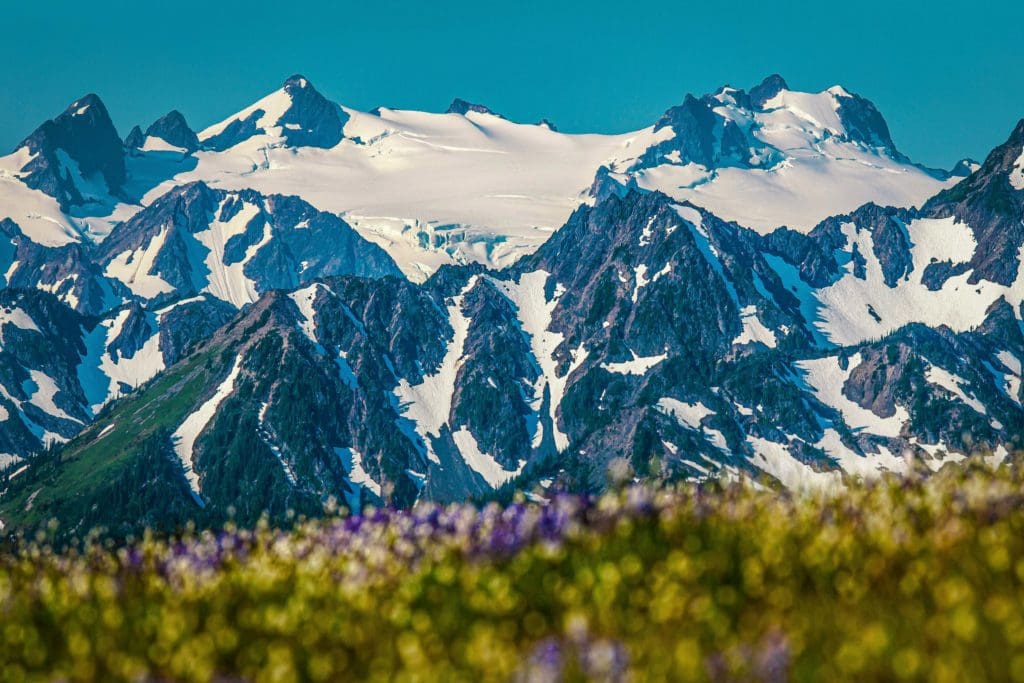
View of Mount Olympus and Blue Glacier from Hurricane Ridge in Olympic National Park, Washington.
Looking For An Amazing Adventure? Book A Guided Hiking or Backpacking Tour in Olympic National Park with REI Adventures.
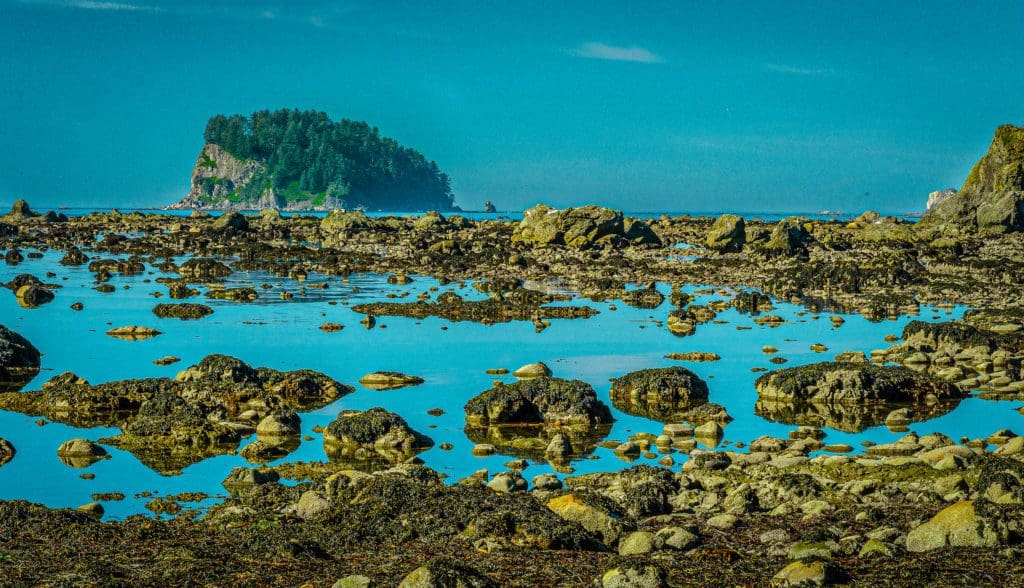
The Ozette Loop Trail is most popular part of the coastal strip in Olympic National Park.
The most popular part of the coastal strip is the 9-mile Ozette Loop. The Park Service runs a reservation and registration program to control the usage levels in this area. From the Ozette Lake Trailhead at the end of the road, the first 3 miles of the trail is a boardwalk-enhanced path through a coastal cedar swamp. It’s a total of 3 miles from here to there. The Makah have traditionally lived here.
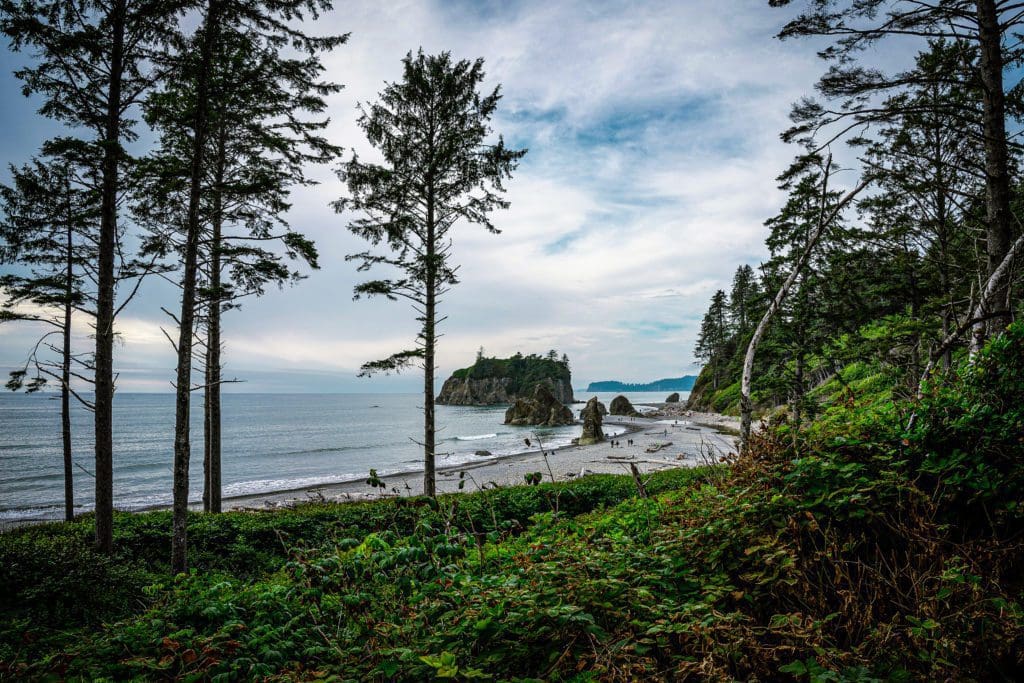
Kalaloch Beach 4 is one of Olympic National Park’s best locations for exploring tide pools.
You can get a good look by checking out Kalaloch Beach 4 and Mora’s Hole in the Wall. Rangers will be happy to explain the tide pool environment to you. Additional tide pools can be found at Second Beach, Third Beach, and Ruby Beach.
Tidepool treasure hunting
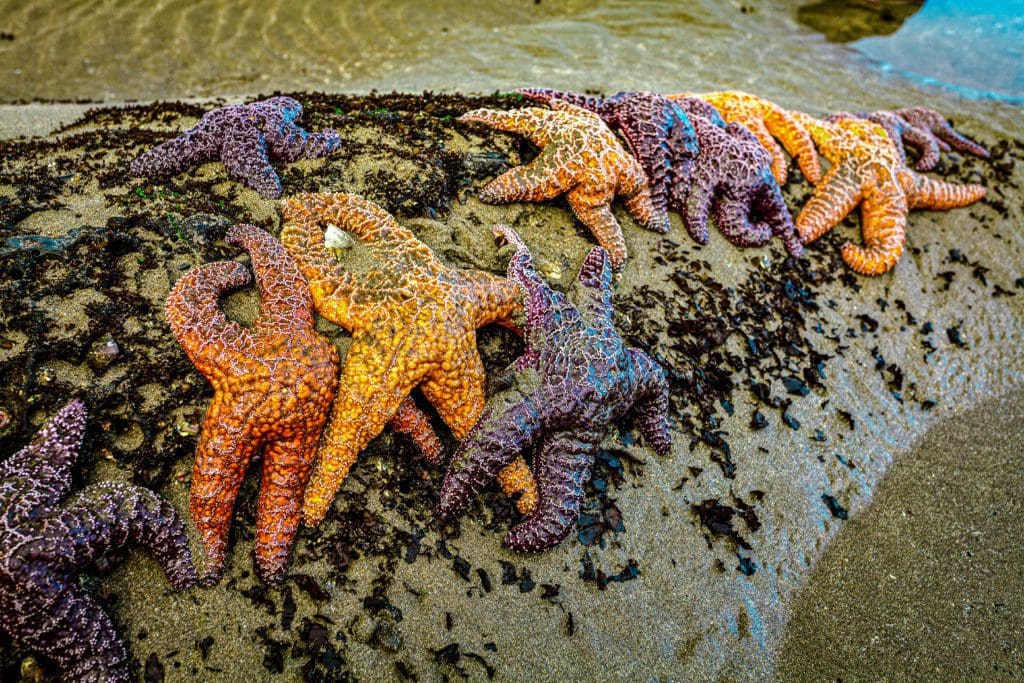
Sea stars pisaster ochraceus clustered in a tide pool at low tide.
Ever wonder what a tide pool is? A tide pool is an area left by the sea when the tide goes out. Tide pools provide a home for hardy organisms, from starfish to anemones. They provide a habitat for changing environments and hazards, with wave activity, strong currents, and exposure to harsh midday sun.
There is something invigorating about the sun, salty air, and refreshingly cool waters. When many people go to the beach, they let their kids explore freely, which they love. This coastal location allows visitors to see rare ocean phenomena more easily. It can be noted that one can look but don’t touch these delicate creatures.
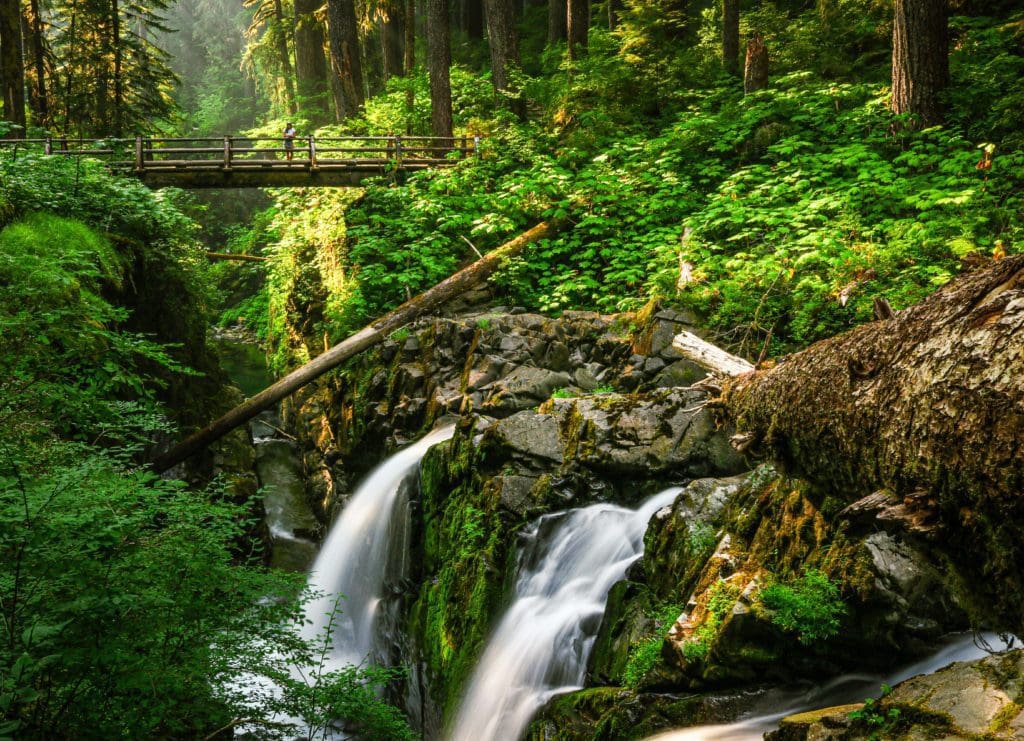
Sol Duc Falls in Olympic National Park, Washington.
Remember to follow the Leave No Trace principles: plan ahead, stay on the trail, pack out what you bring, dispose of waste properly, minimize campfire impacts, be considerate of other hikers, and avoid approaching or feeding wildlife. Whether you’re a nature lover, hiker, or photographer, Olympic National Park has something incredible to offer!
Conclusion
Olympic National Park, a diverse sanctuary, encompasses three distinct ecosystems: glacier-capped mountains, old-growth temperate rainforests, and over 70 miles of wild coastline. Established in 1938, it protects nearly a million acres, including thousands of years of human history. It’s a haven for biodiversity and offers a wealth of educational and learning opportunities. Notable features include Hurricane Ridge, the Hoh Rainforest, and Lake Crescent. The park is a testament to nature’s grandeur, with its unique blend of ecosystems making it a must-visit for nature enthusiasts.









